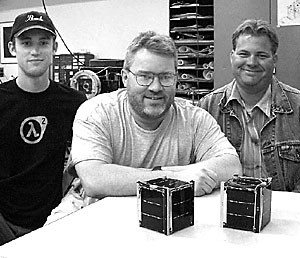After six years of work from more than 50 students, the UA’s CubeSat satellites launched into the air aboard a former Russian nuclear warhead last Wednesday.
Within the hour of launch it was clear that the weapon-of-mass-destruction turned space-hopeful had crashed to the earth, never breaking out of the atmosphere, and along with it were the two UA CubeSats, named Rincon and Sacred.
The UA CubeSats, two 4-inch-by-4-inch satellites, were designed to tumble freely into orbit around the earth while sending information back to the Earth on their speed and temperature.
Despite the launch being a failure – with little to no information from the Russians on what went wrong – the students, faculty and the lone volunteer from the community involved in the project who attended the launch ceremony at Kuiper Space Sciences building didn’t seem too disappointed.
“”To sum it up, the program has been a success; the launch was a failure,”” said Ron Fevig, a planetary sciences doctoral student who has devoted thousands of hours toward the UA CubeSat program.
Although the ultimate goal of the program was to have the UA among the first universities to launch the small satellites into space, the program still accomplished a great deal, said Charlie Cooper, an electrical engineering graduate student and one of the main writers of the Java-based software that would have been used to send and receive data and commands to the CubeSats.
“”Not much has been lost from the CubeSat not making it into space,”” Cooper said. “”The primary payback from this program has already been paid both in the fun and the education we’ve received.””
Programs like UA CubeSat are invaluable to universities as well as to industry and technological advancement, because they provide students with experiences that will aid them in their careers, said Susan Brew, the associate director and program manager of the Arizona/NASA Space Grant Consortium.
“”The payoff to industry is that in the next 10 years about 50 percent of our country’s technical work force will retire, and there aren’t the young people coming up in the ranks to fill the role of the next generation scientists and engineers,”” Brew said.
UA CubeSat allowed students to apply their knowledge to a real project and to expand their knowledge into areas they normally wouldn’t have worked as students, Brew said.
“”This is real-world, hands-on experience that you can’t get in the classroom,”” Fevig said. “”Throughout the program, we always communicated to each other as to what was going on a nearly daily basis, and I think every student had the chance in this program to be at some level involved in every aspect of satellite development and that’s very beneficial to have such a well-rounded perspective.””
The UA CubeSat program also reached across borders in terms of teamwork, as one of the UA CubeSats contained a computer board designed and built by students from Mont Pelat University in France, said Uwe Fink, a planetary sciences professor emeritus and UA CubeSat program manager.
“”There is this sense of community among the people who worked on these projects, which is really very nice,”” Fink said.
Besides providing education and real-world experience for students, the UA CubeSats program was meant to develop “”nanotechnology satellites”” that if proven useful could reduce the cost and time it takes to get into space and conduct science experiments, Fink said.
“”There’s opportunity for a lot of real, good science experiments to add on to these small satellites,”” Fink said.
The data collected by the satellites might provide a cheap way of monitoring global warming by tracking solar temperatures and carbon dioxide levels in the earth’s atmosphere, Fink said.
To date, there has yet to be any amateur satellites or student satellites launched into space that can communicate with each other and then back to Earth, Fink said.
The UA CubeSats had been successful at sending data from one satellite to another and then to the control station on previous tests on the ground, Fink said.
Currently the UA is determining what steps are needed to continue on with the UA CubeSats program and how they can establish steady funding and encourage a larger scale CubeSat program, Fink said. Over the last six years the UA CubeSat program cost about $300,000, which is relatively low, but in order to sustain a CubeSat program across universities like the UA, an ideal budget would be $100,000 to $200,000 annually, Fink said.
Much of the program was funded by private donations and companies like Raytheon and Rincon Research Corporation and the Arizona/NASA Space Grant Consortium, Brew said.
“”We are hoping that somehow through congressional delegations and other people we can get more interest in this and then get NASA and the Air Force and so on to support these types of programs more widely,”” Fink said.
“”One of the biggest problems we’ve had is getting launches from NASA or the Air Force,”” Fink said. “”That’s why we tried to launch on a Russian rocket, but if we can raise some interest for such programs within the nation, then we could have a whole bunch of science payload in mind that would be really useful.””
The two UA CubeSats, as well as another dozen CubeSats from universities and private corporations in California, Hawaii, Montana, Kansas, Japan and Korea, were aboard an Intercontinental Ballistic Missile known as a Dnepr Rocket, which was launched from the Baikonur Base in Kazakhstan by the Russian military. The launch pod holding the CubeSats was organized by California Polytechnic State University in San Luis Obispo, which also served as the information feed to the UA during the launch and eventual crash.









